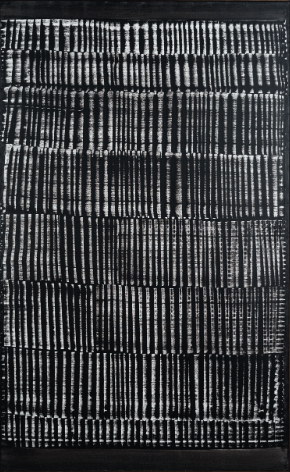HEINZ MACK – PERROTIN
76 rue de Turenne, 75003
from 23 April to 4 June
https://www.perrotin.com/
Heinz MACK
Spectrum
In 1973, the Musée d’Art moderne de la Ville de Paris presented
an important retrospective of Heinz Mack’s work. Yet during the
ensuing decades, as the artist’s career took on international
scope, his presence diminished on the French artistic scene. The
current exhibition thus proposes reviving this essential reformer
from the history of abstract art. With enthusiastic support from
the artist as well as major lenders and institutions, I have selected
for this exhibition a substantial group of more than seventy
works, including some very old ones that have never been
shown in public. The presentation will exceptionally take place
in all of the spaces of the Galerie Perrotin in Paris, and will
link together works of various formats, natures, and periods in
order to highlight the main lines, if not the “whole spectrum,” of
a broad career.
From one period to another, Mack’s esthetic search has been
a constant exploration—both systematic and sensual—of the
lumino-chromatic spectrum and its perceptive thresholds. This
immaterial goal took on a philosophical dimension for the artist,
one that was paradoxically based on highly material means,
and that used the raw simplicity of natural or manufactured
materials such as paint, metal, wood, stone, glass, plexiglass, or
sand. The variability of the manual production, both controlled
and random, as well as this primitivist reduction, make Mack
the source of an exceptional phenomenological unfolding. The
viewer is prompted to feel the tangible experience of vision,
and to consider time and space as entirely separate mediums.
The very first works characteristic of the artist appeared around
1950, in the context of the Arts Academy of Düsseldorf, and then
during his philosophy studies at the local university. From the
beginning the artist favored a willingly abstract and non-figurative
language, while being disappointed in most of the recent
developments in that trend, which he deemed academic and too
indebted to traditional composition and imagery. On the other
hand, the historic avant-garde of Constructivism, Futurism or De
Stijl drew his attention. Around 1953-54, he quickly conceived
paintings, reliefs, and sculptures according to a radical logic,
one that is still unfolding today in his daily practice, at his studios
in Mönchengladbach and Ibiza. This esthetic principle includes
his numerous voyages to the Sahara, where beginning in 1962
his productions and actions prefigured North American Land Art.
The years between 1957-1966 were an equally crucial period:
with Otto Piene and later Günther Uecker (who joined them in
1962), Mack was the founder and central figure of ZERO, a
multifaceted artistic entity and international hub of the kinetic
renewal of abstraction, which had Yves Klein and Jesús Rafael
Soto as members, to name just a few. Numerous institutions,
with the assistance of the ZERO Foundation in Düsseldorf, have
recently endeavored to present this complex movement, from the
Guggenheim in New York to the Stedelijk in Amsterdam, along
with the Martin-Gropius-Bau in Berlin, or the Galeries Nationales
du Grand Palais in Paris with the exhibition “DYNAMO”—whose
title I had suggested in reference to the repeated use of the
term by Mack himself during this historical period. The 1970s
and 1980s fall within a single esthetic singularity, in which a
number of Mack’s sculptures—including numerous steles and
other obelisks that were willingly off scale—engaged in a rich
dialogue with architecture and urban space, primarily throughout
all of Germany.
On his business card, Mack presents himself as a “sculptor and
painter”. The order in which these mentions is important, as it
gives precedence to the modulation of matter in space over
the creation of images on a painting’s surface. In other words,
even the canvases stretched over frames—paintings—from the
ZERO period are covered in a material whose abundant impasto
pushes them toward the relief, that intermediary domain of art
history somewhere between painting and sculpture, and whose
elements are significantly raised from the surface on which they
are fixed. Their appearance remains ambiguous, even paradoxical,
making it difficult to fix them mentally or photographically. For
Mack’s work exists only in a double movement of appearance
and disappearance. The unstable material is constantly eroded
by darkness or light. We have a paradox here—one that is
inseparable from the history of Kinetic art and Perceptual art, of
which Mack was a central figure—between the tangible simplicity
of the material fact, and the insolvable mystery of its effects.
